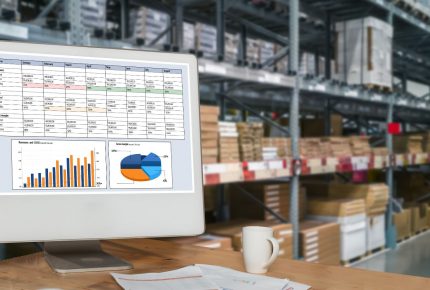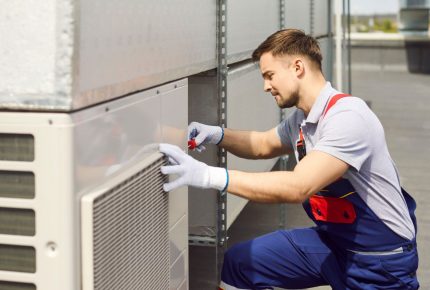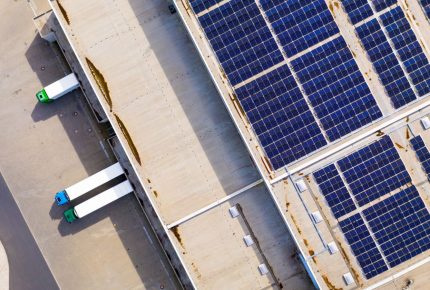Warehouse Energy Efficiency Tips for Fall and Winter

As temperatures drop in fall and winter, warehouse energy efficiency becomes a key focus across the United States, especially for facilities in the northern hemisphere that face extreme cold. Managing energy use becomes crucial to control expenses and maintain a safe working environment. Many strategies can help reduce heat loss, improve heating systems, and optimize energy consumption during colder months.
Improving energy efficiency in a warehouse can be done in several ways. First, insulate the walls and roofs. Next, seal any leaks.
Regularly service the HVAC systems. Finally, upgrade to more efficient lighting options. These actions not only lower utility bills but also create a more comfortable and productive workplace.
Taking steps to prepare a warehouse for colder weather ensures smooth operations and reduces unexpected downtime. Simple, cost-effective changes can make a significant difference in overall energy use and costs through the fall and winter seasons.
Warehouse Energy Efficiency Tips for Fall and Winter
Understanding Fall and Winter Energy Challenges
Warehouses face specific energy challenges during the fall and winter due to colder temperatures and shorter daylight hours. These changes affect heating needs, lighting, and overall energy use in warehouses that require consistent climate control. Identifying the main problems helps improve warehouse energy efficiency and cut energy costs.
Common Seasonal Energy Issues in Warehouses
During fall and winter, warehouses often see higher heating costs because of poor insulation and air leaks. Cold air entering through gaps makes heaters work harder.
Increased use of lighting is another issue as natural light decreases. Many warehouses depend on outdated lighting systems that waste energy.
Other issues include heat loss through dock doors left open and inefficient equipment. These problems cause energy waste and increase bills.
Addressing these common issues often involves sealing leaks, upgrading insulation, and switching to energy-efficient lighting.
Impact of Weather on Warehouse Operations
Cold weather directly affects warehouse energy needs and equipment performance. Low temperatures force heating systems to run longer, increasing fuel or electricity use.
Snow, ice, and wind can cause drafts and damage seals on doors and windows. This lets in cold air and raises heating demand.
Shorter days reduce natural light inside, leading to heavier reliance on artificial lighting for safety and productivity.
Weather conditions may also slow down work processes, requiring more energy to maintain comfortable temperatures and proper lighting.
Assessing Current Energy Consumption Patterns
To improve winter energy efficiency, a warehouse must track when and where energy is used most. This includes monitoring heating, lighting, and equipment power consumption.
Data logging can reveal peak energy times, such as early morning hours or during dock operations. Knowing this helps tailor energy-saving actions.
A detailed assessment may show hidden energy losses like heat leaks or inefficient lighting cycles.
Evaluating current patterns helps prioritize improvements and measure the impact of energy-saving measures.
Insulation and Building Envelope Improvements
Improving insulation and the building envelope helps reduce heat loss and maintain steady indoor temperatures during fall and winter. Attention to existing insulation, sealing openings, and upgrading walls and roofs can significantly lower energy use and expenses.
Evaluating Existing Insulation
Start by inspecting current insulation levels in walls, floors, and ceilings. Areas with missing or thin insulation allow heat to escape, increasing heating costs.
Common signs of poor insulation include cold spots, drafts, and high energy bills. Thermal cameras or professional energy audits can help identify weak spots.
It is important to check insulation types and their condition. Damaged or compressed insulation loses effectiveness. If insulation is outdated or insufficient, adding more can improve energy savings by up to 33%.
Sealing Doors, Windows, and Loading Docks
Doors, windows, and loading docks are major points where heat can leak out. Sealing gaps with weatherstripping, caulking, or draft stoppers can reduce air infiltration.
Loading docks often have large openings, so installing insulated dock doors or adding dock seals and shelters helps keep cold air out.
Regularly inspecting seals and replacing worn parts ensures long-term performance. Even small cracks around frames and joints should be sealed to prevent heat loss.
Upgrading Roof and Wall Insulation
Walls and roofs make up much of the building envelope. Adding insulation in these areas reduces heat transfer significantly.
Exterior wall insulation systems, like Exterior Insulation and Finish Systems (EIFS), improve thermal resistance without reducing interior space.
For roofs, installing thicker or higher-R-value insulation helps retain warmth. Using reflective roofing materials can also reduce heat loss.
Combining insulation upgrades with energy-efficient windows further enhances overall building performance and lowers operational costs.
Optimizing Warehouse Heating Systems
Effective heating in a warehouse balances cost, comfort, and energy use. Choosing the right equipment, controlling heat zones, and maintaining HVAC systems are key steps to improving efficiency and reducing waste.
Selecting Efficient Heating Equipment
Choosing the right heating equipment is crucial for energy savings. Infrared and radiant heaters focus heat on people and objects instead of heating all the air. This reduces energy loss, especially in large, open spaces.
Energy-efficient boilers and furnaces with high Annual Fuel Utilization Efficiency (AFUE) ratings use fuel more effectively. Electric heaters with programmable settings can also be energy smart in smaller areas.
It helps to select equipment sized correctly for the space. Oversized heaters waste energy, while undersized units struggle to maintain temperature. Insulation quality also influences equipment performance.
Zoning and Smart Thermostat Controls
Dividing a warehouse into heating zones allows targeted warming of occupied areas only. This prevents energy waste in unused zones.
Smart thermostats monitor and adjust temperatures automatically. They learn daily patterns and adapt settings for efficiency, cutting unnecessary heating during off-hours.
Wireless controls make zoning manageable without complex wiring. Combined with temperature sensors, they maintain comfort while saving energy.
Zone heating plus smart controls can reduce energy bills by focusing heat precisely where and when it is needed.
Regular Maintenance and Calibration of HVAC Systems
Routine HVAC maintenance keeps systems running efficiently. Cleaning or replacing filters improves airflow and reduces energy use.
Checking ductwork for leaks prevents warm air from escaping. Proper sealing helps maintain steady temperatures with less energy.
Calibration of thermostats ensures accurate readings and system responses. Miscalibrated units can overheat or underheat spaces, wasting fuel.
Scheduled inspections detect wear or damage early, avoiding costly breakdowns and inefficiency over time.
Lighting Strategies for Low-Temperature Months
Efficient lighting reduces energy costs and maintains safety during the colder months when daylight is limited. Adjusting lighting technology and controls ensures the right light is used only when needed, boosting energy savings.
Switching to LED Lighting Solutions
LED lights use less energy and last longer than traditional bulbs. They perform well in cold temperatures without losing brightness or flickering, making them ideal for fall and winter.
LEDs provide instant full light, which improves visibility and safety in warehouses. They also reduce heat output, lowering cooling needs and preventing temperature rises that can affect stored goods.
Switching to LED reduces maintenance costs because bulbs require less frequent replacement. This change can significantly cut warehouse energy bills during months when lighting runs longer.
Utilizing Motion and Daylight Sensors
Motion sensors turn lights on only when areas are in use. This prevents energy waste in empty spaces, especially during nights or less busy shifts.
Daylight sensors dim or switch off lights when enough natural light enters the warehouse. This control is key during fall, when daylight fades early, and winter, when the weather varies.
Combining both sensors maximizes energy savings by adjusting lighting in real-time based on activity and light levels. This approach balances safety with efficiency.
Scheduling Lighting for Shift Changes
Setting lighting schedules to match shift patterns helps avoid unnecessary energy use. Lights can be programmed to power on before workers arrive and turn off shortly after they leave.
This scheduling ensures productivity and safety during work hours while minimizing usage outside of those times. It is especially useful in warehouses operating on multiple shifts or with intermittent occupancy.
Regularly checking and changing schedules based on daylight and shift changes can help save energy and cut costs.
Energy-Efficient Material Handling
Efficient material handling saves energy by reducing unnecessary power use and keeping equipment in good condition. This helps lower costs and keeps operations running smoothly during colder months. Proper care and smart work habits matter most.
Maintaining Energy-Efficient Forklifts and Equipment
Regular maintenance of forklifts and other material handling machines is essential. Checking batteries, oil levels, and tires ensures equipment runs smoothly and uses less energy. Dirty or poorly lubricated parts make machines work harder and waste power.
Switching to electric or energy-efficient models can also reduce energy use. Using eco-friendly equipment designed to consume less power helps lower costs over time. Scheduled inspections and timely repairs prevent breakdowns and keep energy use steady.
Proper charging routines for electric forklifts are important too. Overcharging wastes energy and harms battery life. Operators should follow recommended charging times and avoid charging when not needed. These steps extend equipment life and improve efficiency.
Minimizing Idle Time in High-Traffic Areas
Material handling equipment consumes energy even when it is not moving, but is left running. Limiting idle time, especially in busy zones, cuts unnecessary power use. Operators should turn off machines when not in use or during breaks.
Designating specific parking spots away from high-traffic areas reduces congestion and energy waste from constant start-stop cycles. It also improves safety and workflow.
Using automation and scheduling work carefully helps prevent bottlenecks. This reduces waiting times and keeps equipment moving efficiently. Training staff on energy-saving practices raises awareness and promotes good habits during fall and winter.
Employee Engagement and Best Practices
Engaged employees contribute directly to lowering energy use and cutting costs in warehouses. Focused training and open communication help workers understand their role in energy efficiency and spot issues that waste energy.
Providing Training on Energy-Saving Procedures
Training programs should teach employees how to reduce energy use daily. This includes turning off lights and equipment when not in use, managing HVAC settings, and understanding smart thermostat use during cold months.
Clear instructions on how to handle warehouse equipment efficiently also matter. Workers learn how to avoid unnecessary power use during peak hours and what to do in case of equipment malfunctions that increase energy consumption.
Regular refreshers keep training effective. Using short sessions or visual reminders helps maintain awareness throughout fall and winter when heating needs grow.
Encouraging Employee Reporting of Issues
Workers closest to the operations can spot energy waste quickly. Encouraging them to report leaks, broken equipment, or poor insulation helps fix problems before they become costly.
A simple reporting system increases participation. This might be a digital form, a dedicated email, or a quick checklist supervisors use during rounds.
Recognizing employees who report issues motivates others. Rewards or acknowledgments create a positive culture around energy saving and problem-solving.
Monitoring, Controls, and Automation
Effective energy management in warehouses relies on accurate monitoring and smart control systems. These tools provide clear data on energy use and help automate operations. This leads to better management of heating, lighting, and other energy demands during fall and winter.
Implementing Real-Time Energy Monitoring
Real-time data collection is transforming warehouse energy efficiency management. Installing advanced management systems enables facility operators to view energy use, lighting, and HVAC performance instantly.
Many warehouses install sensors and meters connected to software platforms. These platforms display data visually, making it easy for managers to spot problems.
Monitoring helps prioritize which systems need upgrades or repairs. It also shows the impact of energy-saving actions right away. Over time, this data guides better budgeting and planning for colder months when energy use rises.
Automating Climate and Lighting Systems
Automation uses data from monitoring systems to control heating and lighting without constant human input. For example, HVAC systems adjust temperatures based on occupancy and outdoor conditions.
Smart lighting systems use motion sensors and daylight detection to reduce power when spaces are empty or naturally lit. Automation can also schedule equipment to turn off during non-peak hours, cutting waste.
These technologies reduce energy consumption while maintaining comfort and safety. They improve response times and operational efficiency, helping warehouses balance cost savings with performance during the cold season.
Cost-Benefit Analysis and Return on Investment
Investing in energy efficiency requires careful thought about costs and savings. Understanding potential energy savings and planning the upgrade budget are key steps to making smart investments that work financially.
Estimating Potential Energy Savings
Energy savings can vary by warehouse size, current systems, and improvements made. Companies should start by tracking energy use with monitoring tools. These tools reveal where energy goes and highlight inefficient areas.
Common upgrades include switching to LED lighting, improving insulation, and upgrading HVAC systems. LEDs alone can cut lighting costs by up to 80%, while better insulation reduces heating loss, lowering fuel or electric bills.
Annual savings estimates should compare current energy costs to projected consumption after improvements. Including factors like weather changes during fall and winter refines accuracy. Simple payback time, which measures how long it takes to recover the upgrade cost from energy savings, helps evaluate these investments.
Budgeting for Upgrades and Improvements
Budgeting begins with listing potential improvements and their costs. Typical expenses include equipment, installation, and possible downtime during upgrades.
To prioritize, companies should rank upgrades by cost-effectiveness using simple payback periods. For example:
| Upgrade | Estimated Cost | Annual Savings | Simple Payback (Years) |
|---|---|---|---|
| LED Lighting | $10,000 | $4,000 | 2.5 |
| HVAC Upgrade | $25,000 | $5,000 | 5 |
| Insulation | $15,000 | $3,000 | 5 |
Financing options, incentives, or rebates may lower upfront costs. It is important to include maintenance savings and longer-term benefits when planning budgets. Careful budgeting ensures the company invests in the most effective measures with clear financial returns.
Planning for Future Seasonal Efficiency
Preparing a warehouse for seasonal energy demands means more than quick fixes. It requires setting clear energy goals and regularly reviewing practices to adapt to changing needs. These steps help maintain efficiency and lower costs over time.
Setting Long-Term Energy Goals
Establishing long-term energy goals creates a clear roadmap for reducing energy use during fall and winter. This might include specific targets, like lowering heating costs by 15% or reducing electricity use in lighting by 20%.
Companies should consider investing in energy audits to identify where the most savings are possible. Using this data, they can set measurable, realistic goals based on past performance and future forecasts.
Tracking progress with key performance indicators (KPIs) like utility bills, equipment run time, and temperature control helps keep teams accountable. These goals also support decisions on upgrades, such as installing energy-efficient HVAC systems or LED lighting.
Continuously Reviewing and Updating Practices
Energy efficiency is not a one-time task. Regularly reviewing energy use and operational practices ensures the warehouse remains optimized for each upcoming season.
This can include monthly checks of heating equipment, inspecting insulation, and monitoring lighting schedules. Gathering feedback from staff about comfort and equipment performance also adds insight.
Updating procedures, like adjusting thermostat settings and scheduling equipment usage during off-peak hours, can reduce costs further. The process should also incorporate the latest technology and industry best practices as they become available.
Routine reviews help identify inefficiencies early and prevent avoidable energy waste.
Nebraska Warehouse One-Stop-Shop | TechnologyEnabled 3PL Value-Added Services Warehouse | Freight Broker | Logistics
Nebraska Warehouse doesn’t just help to facilitate your shipments, but we are truly a one-stop-shop solutions provider. Our services include:
- Professional Storage Development and Management
- Quality controlled Environment
- Responsive, Personal Customer Service
- Reasonable Price
- Real Estate Development and Management
- LTL & FTL Shipping
- Refrigerated Trucking & Storage
- E-Technology Software
- Transportation Freight
- Dedicated Contract Warehousing
- 3PL Public Warehousing
- 3PL Specifications
Nebraska Warehouse One-Stop-Shop | TechnologyEnabled 3PL Value-Added Services Warehouse | Freight Broker | Logistics
Nebraska Warehouse doesn’t just help to facilitate your shipments, but we are truly a one-stop-shop solutions provider. Our services include:
Latest News
The latest information about our Omaha storage warehouse services
Get in touch
Address
10064 S 134th Street, Omaha, NE 68138
Telephone
+1 (402) 896-2200









